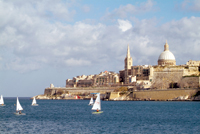
TOURISM has been a key industry for Malta in the last 40 years, contributing largely to employment and foreign-exchange earnings. The industry accounts for up to 25 per cent of the country’s €6.1 billion ($8.6 billion) economy and employs 30 per cent of the population.
While arrivals suffered a drop of 8.4 per cent in 2009, they grew by 12.5 per cent in 2010 reaching 1.33 million visitors – setting a new benchmark. The result earned Malta the title of the best performer in the Mediterranean and one of the best performers overall in Europe.
However, the global economic crisis put pressure on the country when key markets such as the UK cut back on travel. And just when things were beginning to look better, the Arab Spring took place.
According to Malta Tourism Authority (MTA) CEO, Josef Formosa, though it hasn’t brought much positive impact on the tourism front, the developments in Libya have put Malta on the global map. “A lot of people, who had probably never heard of Malta, today know where it is and what we offer.”
The Mediterranean island, which is now looking to attract Arab visitors, expects to see long-term results from this exposure. “In the short term, it hasn’t been good for us, with some conferences that were cancelled; however, we expect to see better results in the long term.”
For many years, the country has attracted a steady flow of holidaymakers from the UK Germany, Italy, Sweden and France. However, besides the core markets, Malta is now looking to benefit from newer markets.
The island is looking to move away from the traditional ‘sun-and-sea’ package holiday destination image by focusing on its 7000-year-old cultural and historical past to attract tourists from new markets, including the Middle East.
“In the last six months, we have increased our awareness in the UAE market. Last year, we had successful joint promotional activities with partners such Emirates and Sega World. We also want to tap into new markets like Russia and Japan, these new markets show great potential in bringing in both leisure as well as corporate guests.
“Another contributing factor towards the increase in our overall figures is the increase in arrivals during the off-season months. At the end of the day, the peak months of July to September are always full. So the bulk of our efforts have been concentrated on the remaining months of the year by going into different niches like Mice, the cultural visitor and our cruise guests,” he added.
MTA has identified some specific goals, such as upgrading its core product, making retail opening hours more accessible, improving the quality of service and the seasonal pattern, as well as growing niche markets such as conferences and incentives as its key priorities.
The cruise industry too has played a key role in the increase in arrival numbers and Malta’s Grand Harbour is one of the most important ports in Europe.
Formosa added: “2011 was expected to be a year of consolidation after the 14-per-cent increase in arrivals we witnessed in 2010. We still believe we can achieve that irrespective of all the political issues in the region. The situation in Tunisia and Egypt had a small effect on our arrival numbers, however the developments in Libya have definitely put Malta on the map. What is interesting is that in the first week of tensions, Google reported 380 million hits on the word Malta!”
